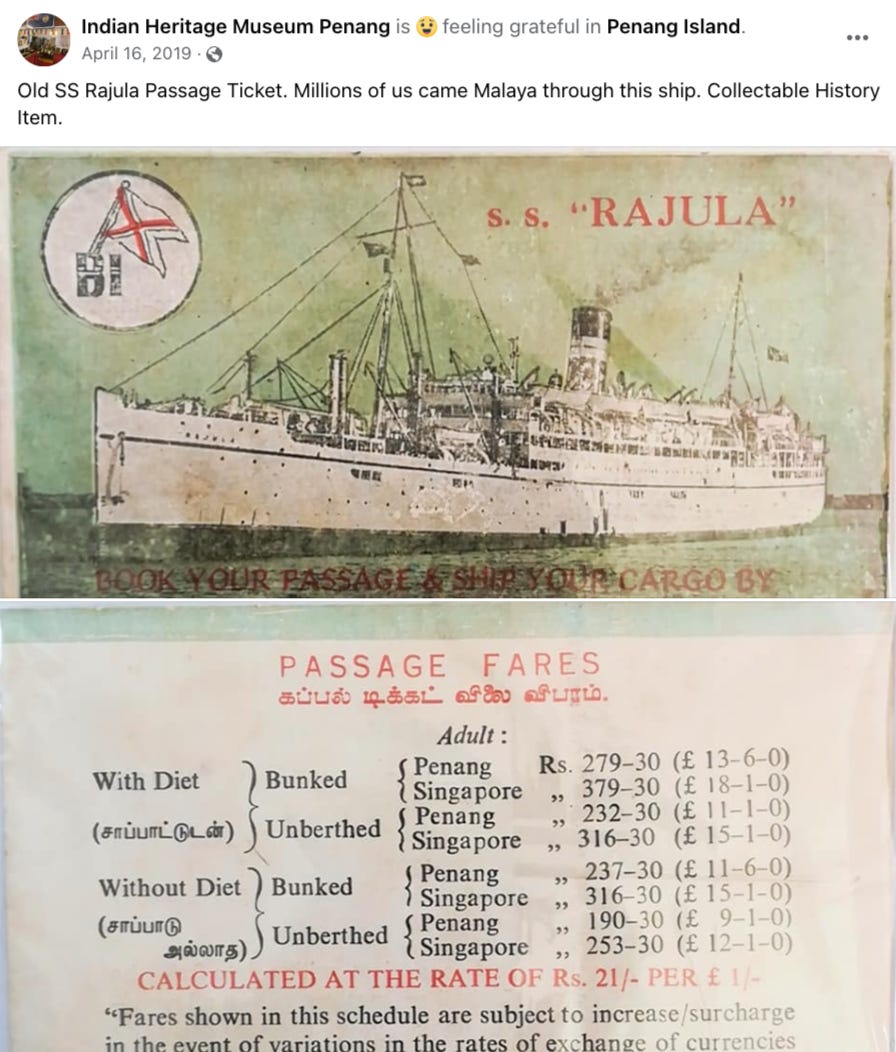I recently re-submitted my manuscript to my editor. In the reshuffle, I had to cut out a neat little bit of history as it no longer fit the shifted timeline.
But instead of consigning this trivia to the graveyard of ships, I thought I’d share a little bit about this character, really a ship — the SS Rajula — and its wonderful career running a tidy little passenger route from Singapore to Madras from the 1920s until her demolition in 1970.
The SS Rajula had some real career highlights; this old lady saw some things:
Commissioned as a passenger-cargo liner for the British India Steam Navigation Company, she was built in Glasgow with her keel laid in 1925 and she was delivered as the Rajula the following year at a cost of £232,733.
She ran her tidy route, ferrying passengers (roughly 1,300 unberthed deck passengers, 425 berthed deck passengers, and a further ~150 first and second class passengers) between Singapore and Madras.
But in 1938, following the Munich crisis, she was called to service as a Personnel Ship and served in “Eastern Waters” until 1943; not much clarity here so perhaps she was involved in clandestine activities!
In 1943, she was transferred to Mediterranean waters, landing troops at Syracuse, Augusta and Anzio. The following year, she returned to familiar waters and was involved in Burmese coast operations as an ambulance transport. In June of 1945, she carried troops for the reoccupation of Rangoon.
In 1947, now in an independent India, she resumed her commercial service after nearly a decade serving the empire.
In 1962, she underwent a major refit at the Mitsubishi yard in Kobe, Japan.
Two years later, departing Penang, she fractured her starboard engine and had to return to Singapore for repairs with a tug escort.
In ’66, she ran through a tropical cyclone on her way from Negapatam to Madras. Seven ships floundered ashore but she “clawed her way stern-first off the coast, along which she had been driven 48km (30 miles) and finally berthed safely at Madras the following afternoon with little damage. The Indian passengers held an impromptu thanksgiving service to the stout old ship on the wharf as they disembarked.”
In 1971, she rescued the fifteen survivors of the Japanese fishing vessel Ohzuru Maru No.1, which had burnt out 485km (300 miles) west of the Nicobar Islands.
In 1973, she was sold to The Shipping Corporation of India and had her name changed to ‘Rangat’ and was used for service to the Andaman and Nicobar islands.
But in August of the following year, she earned her reprieve and was sold to Maharashtra Shipbreaking Co Ltd and, in December, her demolition commenced in the Bombay, the city of my birth.
Farewell, SS Rajula. I’m sorry I couldn’t fit you into my book. But at least, you’re memorialized here.
Ever since visiting our friends Dingo and Janel in Singapore, I’ve been trying to imagine the many currents of maritime trade and travel — places like Penang and Malacca — have started to take on a magical quality for me. Perhaps, it’ll be something I can explore at a later date.
Hope you enjoyed this whimsical departure.
Warmly,
Raghav
P.S. - You can see a lovely painting of the SS Rajula here - LINK
Source: P & O Heritage. Preserving Maritime History.
URL - https://www.poheritage.com/Upload/Mimsy/Media/factsheet/94338RAJULA-1926pdf.pdf





reminded me of the journey i undertook as a child from Mombasa to India way back in 1972